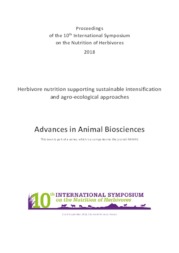In vitro methane and ammoniacal nitrogen production of Marandu grass supplemented with lipid sources.
In vitro methane and ammoniacal nitrogen production of Marandu grass supplemented with lipid sources.
Author(s): COSTA, R.; CABRAL, L.; LIMA, L.; PEDREIRA, B. C. e; MOMBACH, M.; PAULA, N. de; CAMARGO, K.; ROCHA, J. K.
Summary: Ruminal fermentation is a process resulting from the set of microbial activities (metabolism) that transform dietary constituents into products considered useful to animals, such as volatile fatty acids, or useless as methane gas (CH4) which represents a consequent energy loss, resulting in lower animal performance (Valadares Filho and Pina, 2006), besides being considered as one of those responsible for the greenhouse effect. Aiming at efficient production, ruminal fermentation modulation strategies have been used to maximize the fermentation of cellulosic compounds, to reduce fermentation losses (methane and ammonia) and to optimize the synthesis of microbial protein. One of these is the inclusion of lipids in the diet. However, little is known about its effect on tropical forages. The objective of this work was to evaluate the isolated effect of lipid sources from corn and soybean on the production of methane and ammoniacal nitrogen using the in vitro gas production technique.
Publication year: 2018
Types of publication: Paper in annals and proceedings
Keywords: Capim marandu, Cultura In Vitro, Methane, Nitrogen
Observation
Some of Embrapa's publications are published as ePub files. To read them, use or download one of the following free software options to your computer or mobile device. Android: Google Play Books; IOS: iBooks; Windows and Linux: Calibre.
Access other publications
Access the Agricultural Research Database (BDPA) to consult Embrapa's full library collection and records.
Visit Embrapa Bookstore to purchase books and other publications sold by Embrapa.

